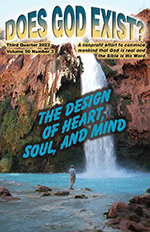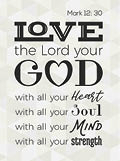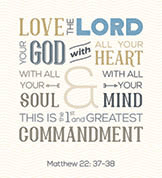Return to 3rd Quarter 2023 articles.


Have you ever had your heart broken? Experiences in our lives tug at us in a way that affects our physical well-being. According to Wikipedia, “Broken heart is a metaphor for the intense emotional stress or pain one feels at experiencing great and deep longing. The concept is cross-cultural, often cited concerning unreciprocated or lost love.” In other words, it is not a minor bump on life's road.
The medical term is “stress-induced cardiomyopathy,” caused by a surge of stress hormones. It can cause dramatic changes in the heart's rhythm and blood pressure. Mental health experts tell us that heartbreak goes through various stages of denial, anger, bargaining, depression, and acceptance.

Psalm 139:14 finds David saying, “I will praise you [God] for I am fearfully and wonderfully made: marvelous are your works, and that my soul knows very well.” In Mark 12:30, Jesus refers to the ten commandments by saying that the greatest commandment tells us to “love the Lord your God with all your heart, and with all your soul and with all your mind … .” God has created these three designed parts of a human that are present in all of us. This is why Jesus gave his followers the unique command to love not only their brothers but even their enemies. That command is centered on the fact that all humans are of infinite worth because they are created in God's image.
The naturalist philosophy would say that all love is only in the brain, but the Bible tells us there is more to human emotions than the physical heart and brain. The Old Testament uses the term “heart” (Hebrew, leb and “lebab) in many different ways. Only 29 of those uses refer to physical existence. It means inner life or character 257 times. Another 166 times, it refers to emotional states of consciousness, including intoxication, joy, sorrow, courage, or fear. It references intellectual activities 204 times. (For example, see 1 Kings 3:9 and Exodus 28:30.) Finally, 195 times, these words refer to volition or purpose (for example, 1 Samuel 2:35) (reference: The New Bible Dictionary, Wm. B. Eerdmans Publishing Company, Grand Rapids).
In Luke 24:32, when Jesus appeared to Cleopas and his friend, they said, “Did not our heart burn within us while he talked with us on the road?” The brain is an essential part of our physical being, but we believe that how we act is not just a function of our brain. The fact that we are created in the image of God has to do with our spiritual makeup, not the physical. Our brain brings information to the body, but God's Spirit also works on us. Acts 2:38 tells us that when we are baptized into Christ, we “receive the gift of the Holy Spirit.”

The bottom line is that our physical hearts are vital for existence, but there is something not physical within us that we refer to as the “heart.” Jesus said, “You shall love the Lord your God with all your heart, with all your soul, and with all your mind” (Matthew 22:37). The design of heart, soul, and mind working together in harmony to love God allows us to love one another. The apostle John wrote, “If someone says, ‘I love God,’ and hates his brother, he is a liar, for he who does not love his brother whom he has seen, how can he love God whom he has not seen?”rdquo;
Our heart must be right to follow the instructions of Jesus, “A new commandment I give to you, that you love one another; as I have loved you, that you also love one another. By this, all will know that you are my disciples, if you have love for one another” (John 13:34-35).
Picture credits:
Roland Earnst
Cover photo: Roland Earnst
© lukpedclub. Image from BigStock.com
© lukpedclub. Image from BigStock.com
Scripture links/references are from BibleGateway.com. Unhighlighted scriptures can be looked up at their website.
